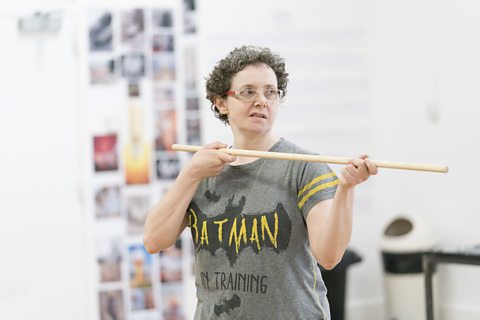Performers
Health and safety is not just an issue for the design elements of the theatre. Performers need to ensure that their own health and safety and that of the audience is central to rehearsalThe process of preparing a production and getting it ready for performance. and performances.
To prevent injury, performers should warm upTo ease the body or voice into activity to prevent injury, eg through stretching or gentle exercises., cool downThe process after exercising the voice or body to prevent injury, eg doing stretches. and wear appropriate footwear and clothing, particularly when choreographTo arrange or compose a sequence of moves. physical theatreA mime technique in which actors use their bodies to create props or part of the set., stage combatChoreographed fighting. or dance sequences. It is important to ensure the moves in physical sequences are well rehearsed and planned according to the actual performing space and size, practising with the set and scenery marked out and avoiding the edge of the stage to prevent falls. Water should be kept away from all electrical equipment and the set to prevent damage and slipping.
Vocal warm-ups are just as important as physical. It is important to rest the voice and drink plenty of water in the run-up to a performance, as well as practise good posture and breathing exercises.
The location of the audience should be considered, especially if they are unlikely to stay still, eg young children and when performing in a promenade stagingWhen the audience can move around and follow the action during a performance. configuration. If any moves might injure the audience as the actor moves through the aisles, they will need to be rethought.
Performers need to protect themselves from injury by anticipating problems that might occur during a live show. For example, broken props or falling scenery can be dangerous and debris will need to be cleaned up to prevent slipping or falling, before it is safe to continue. stagehandThe people responsible for moving set and props on and off of the stage. should have equipment ready in the wingsThe side areas that lead off the stage. in case a clean-up is needed.
Performers will rehearse in costume and should spend time familiarising themselves with the costume’s movement constraints. If the costume is not suitable for the type of movement required on stage or poses a hazard, then this needs to be addressed as soon as possible.
Real weapons should never be used on stage. Stage versions are available that include safety features to protect the performers and crew who are handling the items.

More guides on this topic
- Responding to a stimulus - OCR
- Developing an idea - OCR
- Selecting a genre or performance style - OCR
- Selecting a practitioner - OCR
- Rehearsing for a performance - OCR
- Refining a performance - OCR
- Interpreting and performing a character - OCR
- Designing for productions - OCR
- Creating a portfolio or devising log - OCR